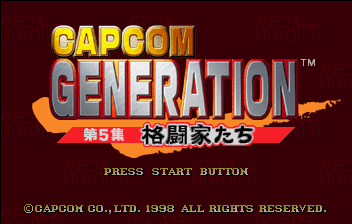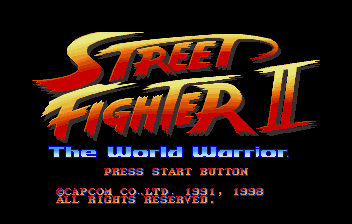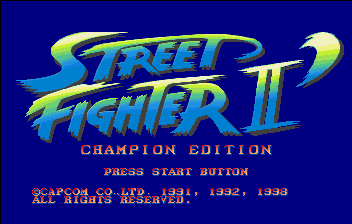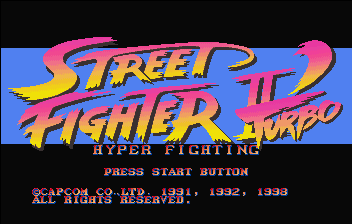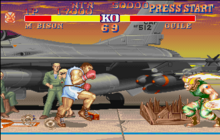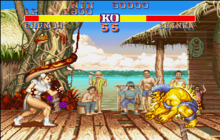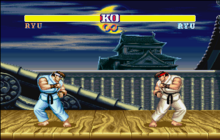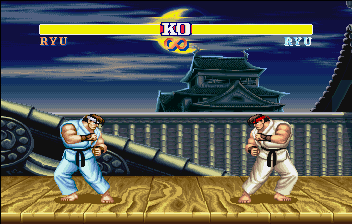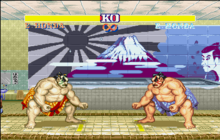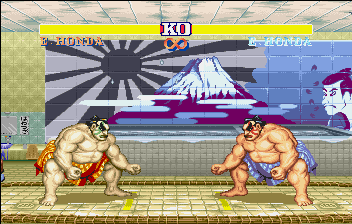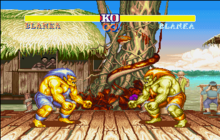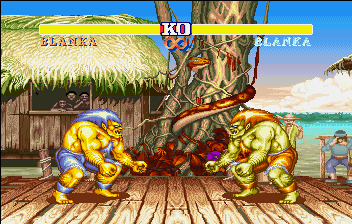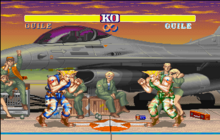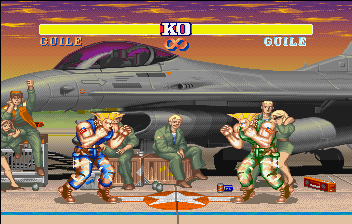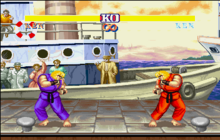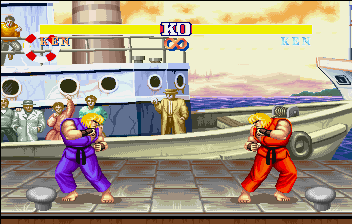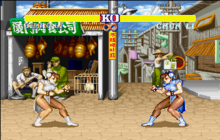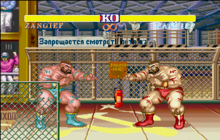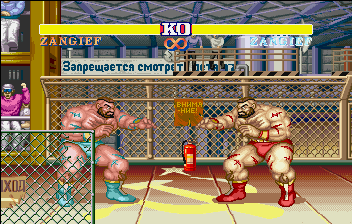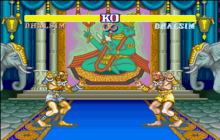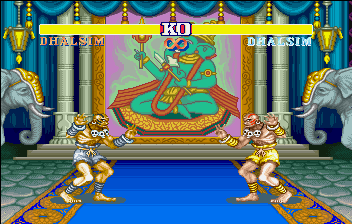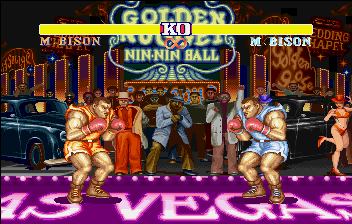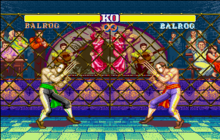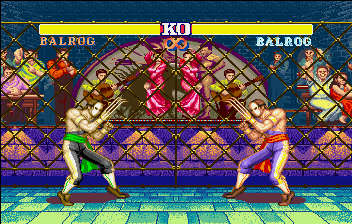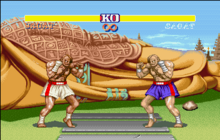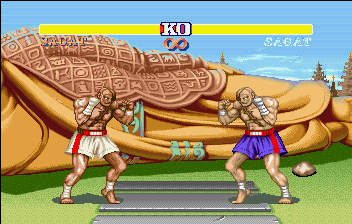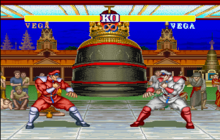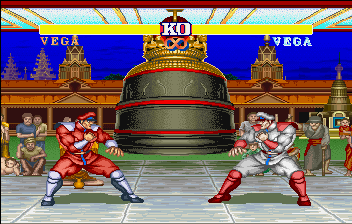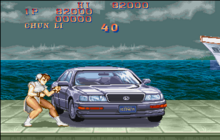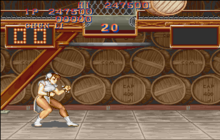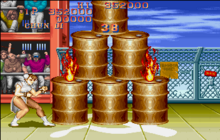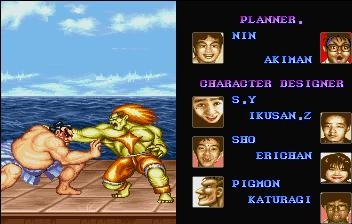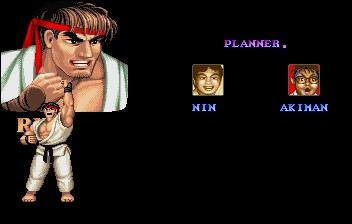Capcom Generation: Dai 5 Shuu Kakutouka-tachi
From Sega Retro
| ||||||||||
| Capcom Generation: Dai 5 Shuu Kakutouka-tachi | ||||||||||
|---|---|---|---|---|---|---|---|---|---|---|
| System(s): Sega Saturn | ||||||||||
| Publisher: Capcom | ||||||||||
| Developer: Capcom | ||||||||||
| Original system(s): Capcom CPS-1 | ||||||||||
| Game total: 3 | ||||||||||
| Sound driver: SCSP (1 track) | ||||||||||
| Genre: Compilation, Fighting/Taisen Kakutou (対戦格闘)[1], Action[2] | ||||||||||
| Number of players: 1-2 | ||||||||||
| ||||||||||
|
Capcom Generation: Dai 5 Shuu Kakutouka-tachi (カプコン ジェネレーション 第5集 格闘家たち, "The Fighters") is the fifth of five Capcom Generation compilations, released for the Sega Saturn and PlayStation in 1998.
The compilation includes faithful ports of the first three arcade releases of Street Fighter II, originally released for Capcom's CPS-1 hardware. The last two arcade releases, released for Capcom's CPS-2 hardware, were previously compiled on Street Fighter Collection.
Contents
Games included
- Street Fighter II: The World Warrior
- Street Fighter II′: Champion Edition
- Street Fighter II′ Turbo: Hyper Fighting
Every game has a "Collection" with artwork (including promotional art and concept art), character profiles, and game tips. Options and high scores can be saved to the Saturn's internal memory.
Story
As part of his global domination plan, Vega sets up a tournament to find the world's best fighters to brainwash into his criminal organization Shadaloo.
Gameplay
This release is a compilation of the first three versions of Street Fighter II, which are one-on-one fighting games in which the player engages opponents in a series of timed, close-quarters combat matches. Street Fighter II, originally released in 1991, revolutionized the fighting game genre by introducing a greater emphasis on command-based special moves, a combo system, a six-button layout for attacks, a wide selection of playable characters with unique fighting styles, and competitive two-player play. In order to win a round, the player must either completely drain the opponent's health bar by landing attacks or have more health than the opponent when time runs out. Neither fighter wins the round if they have equal health when time expires or if they simultaneously knock each other out. The first fighter to win two rounds is the victor of the match.
Champion Edition, originally released in early 1992, adds the ability to play as the four boss characters and play matches against the same character. The character portraits and endings of many characters were redrawn, and the color palette for every stage was changed. Hyper Fighting, originally released in late 1992, introduces a faster playing speed and new special moves for several characters. Both versions of the game introduced numerous balance changes.
Characters move with ![]() and
and ![]() and crouch with
and crouch with ![]() . They jump with
. They jump with ![]() and flip back and forth with
and flip back and forth with ![]() and
and ![]() . Punches are done with
. Punches are done with ![]() (jab),
(jab), ![]() (medium), and
(medium), and ![]() (fierce) and kicks are done with
(fierce) and kicks are done with ![]() (short),
(short), ![]() (medium), and
(medium), and ![]() (roundhouse). Light attacks are faster but do less damage, while hard attacks are slower but deal more damage. Slower attacks leave the character vulnerable for longer if they miss the opponent. Quick attacks can be linked together, with some moves flowing into each other and forming combination attacks (combos) that cannot be blocked once started.
(roundhouse). Light attacks are faster but do less damage, while hard attacks are slower but deal more damage. Slower attacks leave the character vulnerable for longer if they miss the opponent. Quick attacks can be linked together, with some moves flowing into each other and forming combination attacks (combos) that cannot be blocked once started.
In addition to their regular punches and kicks, every character has multiple special moves, typically showcasing superhuman capabilities. Half of the roster predominantly uses motion-based inputs, where special moves are performed by rolling the D-Pad in a semicircular motion, such as a quarter circle, followed by a punch or a kick button. The strength of the attack button affects the damage inflicted by the special move and often other characteristics, such as the movement speed of a projectile or the distance traveled by the maneuver. The remaining characters use "charged" inputs, where special moves are performed by holding the D-Pad in one direction for at least two seconds to "charge" the attack, then moving the D-Pad in the opposite direction and pressing a punch or a kick button. Charged inputs require more preparation than motion inputs in order to build the charge, but in return, they generally have a quicker recovery time, leaving the character vulnerable for less time after performing the move.
Blocking is done by holding the D-Pad away from the opponent, with special moves still doing a small amount of "chip damage" if blocked. Characters can block while standing, which blocks against high and mid attacks but not low attacks (such as sweeps), or crouching, which blocks against mid and low attacks but not high attacks (such as jumping attacks). Characters can become dizzy from being attacked repeatedly; they are uncontrollable and vulnerable in this state but can recover more quickly by rapidly pressing back and forth on the D-Pad along with the attack buttons. It is also possible to escape grabs in this way.
Throws and grabs are done by holding ![]() or
or ![]() when next to an opponent and pressing a medium or hard punch or kick button. Throws cannot be blocked. Different characters have different throws available to them, and some characters can throw in midair.
when next to an opponent and pressing a medium or hard punch or kick button. Throws cannot be blocked. Different characters have different throws available to them, and some characters can throw in midair.
Modes
Every game has the same modes:
- Arcade Mode: A series of matches against computer-controlled opponents, ending with the four Shadaloo bosses M. Bison, Balrog, Sagat, and Vega. The game ends if the player loses a match but can be continued an unlimited number of times. A second player may join at any time by pressing START on a second control pad to start a head-to-head match. The winner continues the game in single-player mode. There are eight different difficulty levels for computer-controlled opponents. After every three matches, the player plays a bonus stage.
- Versus Mode: A dedicated two-player mode where players can choose a handicap, choose the number of rounds to play (1, 3, or 5), and pick any stage to play.
- CPU Battle: A one-player mode where the player chooses a character to play and a character to fight, then plays a match against a computer-controlled opponent. This mode is unlocked after completing the Arcade Mode without using a continue.
- Training Mode: A practice mode where the player can practice playing a character against a non-hostile opponent, with no time limit and infinite vitality. There is a recording option, and the dummy character can be set to stand, crouch, or jump.
- Super Versus: A special two-player mode where players can choose any version of any character from all three games. This mode is unlocked and appears on the main menu after completing the Arcade Mode for every game.
Characters
Note: Move lists assume that the character is facing right. When facing left, ![]() and
and ![]() should be reversed.
should be reversed.
| P | Any punch button |
| LP | Light punch |
| MP | Medium punch |
| HP | Hard punch |
| K | Any kick button |
| LK | Light kick |
| MK | Medium kick |
| HK | Hard kick |
For moves that require pressing all three P or K buttons, pressing any two buttons also works.
Playable
In Champion Edition and Hyper Fighting, every character has two selectable color schemes, one chosen by pressing any attack button and a secondary color scheme chosen with START (and also used for mirror matches). Hyper Fighting gives every character a new primary color scheme and uses the original color schemes as the secondary colors.
Bosses
The four boss characters are only playable in Champion Edition and Hyper Fighting.
Origin: Date of birth: 1968-09-04
Height: 6'5"
Weight: 252 lbs.
Blood type: A
|
M. Bison (Balrog) | ||||||||||||||||||||
An American boxer who was once one of the world's greatest heavyweight boxers. He began working for Shadaloo for easy money. All of his attacks are performed with punches and similar strikes such as elbows or headbutts, including moves performed with the kick buttons.
| |||||||||||||||||||||
Origin: Date of birth: 1967-01-27
Height: 6'0"
Weight: 208 lbs.
Blood type: O
|
Balrog (Vega) | ||||||||||||||||||||
A vain Spanish bullfighter who wields a claw and uses a unique style of ninjutsu. He fights with a claw on one hand, which can be broken from blocking too many hits, reducing the damage of his punches.
| |||||||||||||||||||||
Origin: Date of birth: 1955-07-02
Height: 7'4"
Weight: 283 lbs.
Blood type: B
|
Sagat | ||||||||||||||||||||
A Muay Thai kickboxer from Thailand and former World Warrior champion. His defeat at the hands of Ryu's dragon punch left a deep gash across his chest.
| |||||||||||||||||||||
Origin: Date of birth: Unknown
Height: 5'11"
Weight: 254 lbs.
Blood type: A
|
Vega (M. Bison) | ||||||||||||||||||||
The leader of the criminal organization Shadaloo, who uses a mysterious power known as Psycho Power. He is the final opponent of the game.
|
Stages
- Main article: Capcom Generation: Dai 5 Shuu Kakutouka-tachi/Comparisons.
Each character has his or her own stage where matches are hosted. The stage can be manually chosen in the two-player mode.
Bonus stages
A bonus stage appears in the single-player game after every three matches won. Characters destroy inanimate objects within a time limit by attacking them for bonus points.
History
Release
While the Saturn version was only released in Japan, the PlayStation version was released internationally as Street Fighter Collection 2 (marketed as a sequel to Street Fighter Collection). This was the only North American release of a Capcom Generation volume.
Production credits
Street Fighter II: The World Warrior
- Planner: Nin, Akiman
- Character Designer: S.Y, Ikusan.Z, Sho, Erichan, Pigmon, Katuragi, Mak!!, Manbou, Ballboy, Kurisan, Q Kyoku, Mikiman, Tanuki, Yamachan, S•Taing, Nissui, Buppo, Ziggy, Zummy, Nakamura, Okazaki
- Programmer: Shin., Marina, Marina, Ecchro!
- Sound: Shimo-P., Oyaji-Oyaji
- Special Thanks: CBX, Poo, Kanekon, Shono.
Street Fighter II′: Champion Edition
- Planner: Nin, Akiman
- Character Designer: S.Y, Ikusan.Z, Sho, Erichan, Pigmon, Katuragi, Mak!!, Manbou, Ballboy, Kurisan, Q Kyoku, Mikiman, Tanuki, Yamachan, S•Taing, Nissui, Buppo, Ziggy, Zummy, Nakamura, Okazaki
- Programmer: Shin., Marina, Macchan, Ecchro!
- Sound: Shimo-P., Oyaji-Oyaji
- Design Support: D.James
- Special Thanks: CBX, Poo, Kanekon, Shono., Hirakin., Nac Kai, Erlingr Ogachy, Zenji., Super•Cheap•Joe
Street Fighter II′ Turbo: Hyper Fighting
- Planner: Poo, Nin, Akiman
- Character Designer: S.Y, Sho, Pigmon, Ikusan.Z, Erichan, Katuragi, Mak!!, Ballboy, Q Kyoku, Tanuki, S•Taing?, Manbou, Kurisan, Mikiman, Yamachan, Nissui, Buppo, Zummy, Ziggy, Y.Nakamura, M.Okazaki
- Programmer: Shin., Kid, Watari
- Design Support: D.James
- Sound: Shimo•P., Oyaji Oyaji.
- Special Thanks: CBX, Kanekon, Shono, Nac Kai, Erlingr Ogachy, Zenji, Super•Cheap•Joe
Magazine articles
Promotional material
Physical scans
| Sega Retro Average | ||||||||||||||||||||||||
|---|---|---|---|---|---|---|---|---|---|---|---|---|---|---|---|---|---|---|---|---|---|---|---|---|
|
| 69 | |
|---|---|
| Based on 4 reviews | |
Technical information
References
- ↑ File:CapcomGeneration5 Saturn JP Box Back.jpg
- ↑ 2.0 2.1 https://sega.jp/history/hard/segasaturn/software_l.html#tab04 (Wayback Machine: 2019-12-07 02:59)
- ↑ Dreamcast Magazine, "1998-05 (1998-12-18)" (JP; 1998-12-04), page 5
- ↑ File:Street Fighter II Saturn credits.pdf
- ↑ File:Street Fighter II Champion Edition Saturn credits.pdf
- ↑ File:Street Fighter II Hyper Fighting Saturn credits.pdf
- ↑ Consoles News, "Février 1999" (FR; 1999-0x-xx), page 84
- ↑ Dreamcast Magazine, "1998-04 (1998-12-11)" (JP; 1998-11-27), page 200
- ↑ Famitsu, "1998-12-11" (JP; 1998-11-27), page 1
- ↑ Sega Saturn Magazine, "Readers rating final data" (JP; 2000-03), page 12
| Capcom Generation: Dai 5 Shuu Kakutouka-tachi | |
|---|---|
|
Main page | Comparisons | Hidden content | Magazine articles | Reception | Technical information | |
| Capcom Generation compilations | |
|---|---|
| Capcom Generation: Dai 1 Shuu Gekitsuiou no Jidai (1998) | Capcom Generation: Dai 2 Shuu Makai to Kishi (1998) | Capcom Generation: Dai 3 Shuu Koko ni Rekishi Hajimaru (1998) | Capcom Generation: Dai 4 Shuu Kokou no Eiyuu (1998) | Capcom Generation: Dai 5 Shuu Kakutouka-tachi (1998) |
| Street Fighter games for Sega systems | |
|---|---|
| Street Fighter II': Champion Edition (unreleased) | Street Fighter II': Special Champion Edition (1993) | Super Street Fighter II: The New Challengers (1994) | |
| Street Fighter: The Movie (1995) | Street Fighter Alpha: Warriors' Dreams (1996) | Street Fighter II Movie (1996) | Street Fighter Alpha 2 (Dash) (1996) | Super Puzzle Fighter II Turbo (1996) | Street Fighter Collection (1997) | X-Men vs. Street Fighter (1997) | Pocket Fighter (1998) | Marvel Super Heroes vs. Street Fighter (1998) | Capcom Generation: Dai 5 Shuu Kakutouka-tachi (1998) | Street Fighter Zero 3 (1999) | |
| Street Fighter II' (1997) | |
| Street Fighter Alpha 3 (1999) | Street Fighter III: Double Impact (1999) | Street Fighter III: 3rd Strike (2000) | Super Street Fighter II X for Matching Service (2000) | Street Fighter Zero 3 for Matching Service (2001) | Super Puzzle Fighter II X for Matching Service (2001) | |
| Street Fighter Zero 3 Upper (2001) | |
| Sampler discs | |
| Street Fighter Zero 2 Taikenban (199x) | Street Fighter Collection Taikenban (1997) | |
| Street Fighter Zero 3 Tentou Taikenban (199x) | |
| Unlicensed Street Fighter games for Sega systems | |
| Jang Pung II (1993) | |
| X-Men vs. Street Fighter (Mega Drive) (1998) | |
